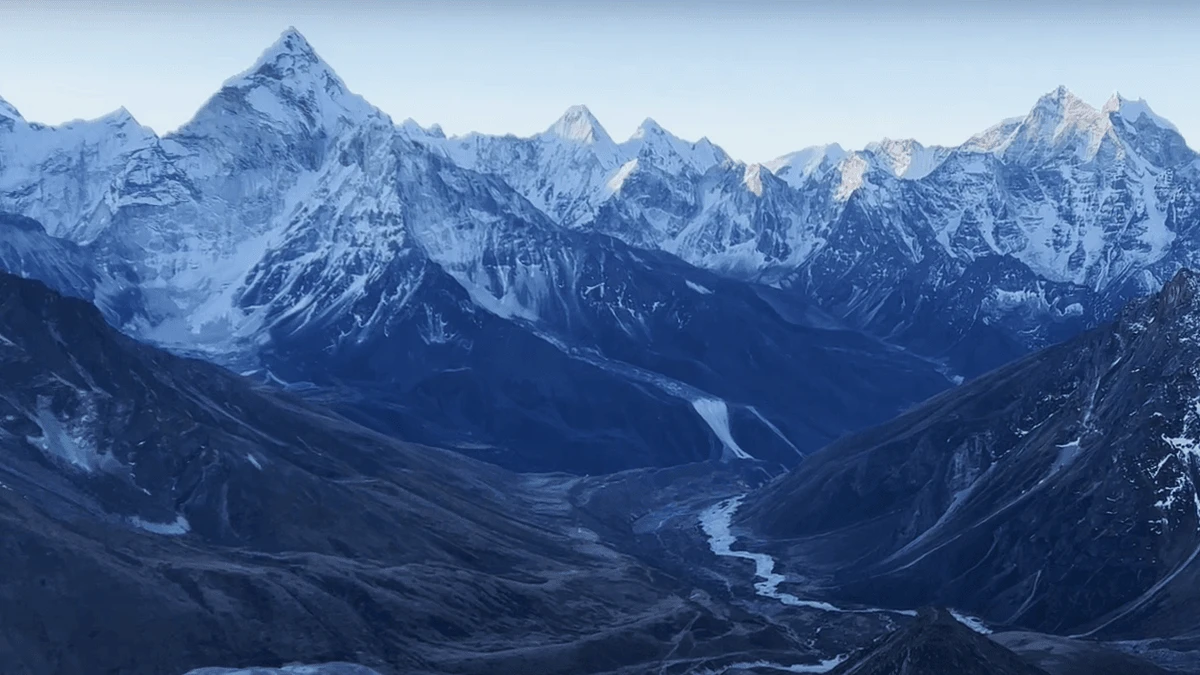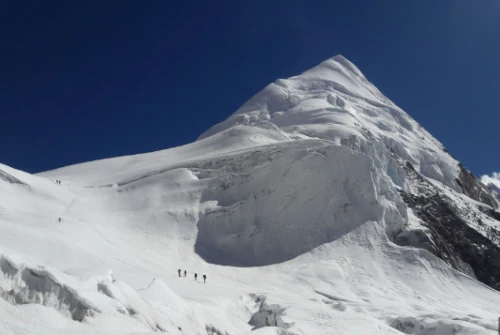Overview Lobuche Peak Climbing
Lobuche Peak Climbing is one of the most thrilling alpine adventures in the majestic Everest region of Nepal, perfectly tailored for ambitious trekkers eager to take their first steps into the exhilarating world of Himalayan mountaineering. Towering at an impressive altitude of 6,119 meters (20,062 feet), the summit of Lobuche Peak rewards climbers with breathtaking panoramic views of some of the world’s most iconic peaks, including Mount Everest, Lhotse, Nuptse, Ama Dablam, and the vast, ice-laden expanse of the Khumbu Glacier.
Unlike the more popular Island Peak, Lobuche Peak Climbing is notably more technically demanding, making it an ideal challenge for adventure seekers who possess basic mountaineering skills or have prior high-altitude trekking experience. The climb involves the use of ropes, crampons, and ice axes, offering a true taste of alpine climbing that is both physically demanding and emotionally rewarding.
Expertly organized by All Nepal Hiking, this guided expedition emphasizes safety, professional logistics, and in-depth acclimatization, ensuring a life-changing Himalayan journey filled with awe-inspiring landscapes and meaningful cultural encounters in remote Sherpa villages.
The journey typically begins with your arrival in Kathmandu, where you’ll prepare for the adventure ahead and explore the bustling capital city. From there, a scenic and thrilling flight takes you to Lukla, the gateway to the Khumbu region. The trekking route then winds its way through legendary Sherpa settlements such as Namche Bazaar, Tengboche, and Dingboche, offering time to soak in spectacular mountain scenery and rich Himalayan culture. To ensure proper acclimatization, a rest and exploration day is included at Kala Patthar or Gorak Shep, providing close-up views of Everest and surrounding peaks.
As the trail ascends, you’ll make your way to Lobuche Base Camp, where final preparations for the summit push begin. The summit attempt via the Southeast Ridge is the highlight of the expedition a physically challenging but incredibly rewarding climb to the top of Lobuche Peak. After reaching the summit and taking in the unparalleled 360-degree Himalayan panorama, the descent begins, leading back to Lukla, where a final flight returns you to Kathmandu, marking the end of an unforgettable adventure.
For those looking to further elevate their experience, combo peak climbing options are also available, combining Mera Peak, Island Peak, and Lobuche Peak into one extended expedition ideal for climbers seeking a deeper immersion in Nepal’s high-altitude wilderness and mountaineering culture.
Lobuche East Peak Climbing – Ideal for Ambitious Trekkers
Lobuche East Peak Climbing is the more popular and accessible of the two Lobuche summits Lobuche East and Lobuche West making it an ideal choice for ambitious trekkers eager to venture into the world of Himalayan climbing. While Lobuche West is categorized as an expedition peak that demands advanced technical skills, specialized gear, and a separate climbing permit, Lobuche East is officially designated as a "trekking peak" by the Nepal Mountaineering Association (NMA). This classification makes it a more approachable option for physically fit, well-prepared adventurers with basic mountaineering experience.
The route to Lobuche East gains elevation gradually as it follows the legendary Everest Base Camp trek, a classic trail that passes through Sherpa villages and alpine terrain offering excellent opportunities for acclimatization. This gradual ascent helps prepare climbers for high-altitude conditions before reaching Lobuche East Base Camp, located at approximately 5,200 meters.
From the base camp, the standard summit route ascends along the southeast ridge, which includes technical sections involving snow, ice, and rock. These segments require the use of mountaineering equipment like crampons, harnesses, ropes, and ice axes, but remain manageable for those with previous trekking peak experience or basic alpine training.
What truly sets Lobuche East Peak Climbing apart is the peaceful, remote atmosphere of the route and the jaw-dropping panoramic views from the summit. On a clear day, climbers are rewarded with an unforgettable Himalayan skyline, featuring Everest, Lhotse, Nuptse, Ama Dablam, and many other soaring giants of the Khumbu region.
Whether you’re seeking a challenging next step after high-altitude trekking, or aiming to gain alpine climbing experience in a world-class setting, Lobuche East Peak offers the perfect blend of adventure, solitude, and stunning natural beauty.
Why Choose Lobuche East Peak Climbing?
Lobuche East Peak Climbing is an ideal introductory mountaineering adventure in Nepal, perfect for trekkers aiming to summit a 6,000-meter Himalayan peak for the first time. It combines the classic Everest Base Camp trek, the dramatic Kala patther, and a technical but achievable alpine ascent, all in one carefully crafted itinerary.
The journey offers exceptional views of Mount Everest, along with other iconic peaks such as Lhotse, Nuptse, Ama Dablam, Makalu, and Pumori, especially from the summit of Lobuche East at 6,119 meters. This makes the expedition both visually stunning and deeply rewarding.
Designed with proper acclimatization in mind, the itinerary includes multiple high-altitude stays and hikes like Everest Base Camp and Kala Patthar to help your body adapt gradually before the final summit push. It also features pre-climb training at Lobuche High Camp, where you'll practice with fixed ropes, crampons, and harnesses under the guidance of experienced Sherpa climbing guides.
One of the biggest advantages of climbing Lobuche East is its relatively quiet approach route,less crowded than Island Peak or Mera Peak. This provides a more peaceful, focused climbing experience without sacrificing the stunning beauty or thrill of a major Himalayan peak.
Importantly, this expedition is accessible even to beginners with no prior mountaineering experience, as long as you have a good level of fitness and a spirit for adventure. With professional support, acclimatization, and technical guidance, Lobuche East offers the perfect gateway into high-altitude climbing in the Nepal Himalayas.
Lobuche East Peak Difficulty & Technical Details
Lobuche East Peak is rated between PD+ to AD on the Alpine Grading System, placing it in the moderate to fairly difficult category perfect for climbers looking to push beyond basic trekking peaks into more technical alpine challenges.
The ascent involves a diverse mix of terrain, including snow slopes up to 50 degrees, rocky ridgelines, and occasionally glaciated sections with crevasses, all of which demand careful footing and solid technical skills. Climbers must be prepared to use essential mountaineering equipment such as crampons, harnesses, helmets, ice axes, and ascend using fixed ropes on steeper or exposed sections, particularly along the summit ridge.
In terms of difficulty, Lobuche East is more demanding than Island Peak, both in terms of technical elements and physical endurance. This makes it an excellent choice for climbers who want to build alpine experience before attempting higher and more serious peaks.
If you're preparing for future high-altitude objectives and wondering what is the easiest 8000-meter peak to climb, Lobuche East offers the perfect training ground. It is especially suitable for those aiming for climbs like Cho Oyu, widely considered one of the most approachable 8000ers. Tackling Lobuche East first helps develop the technical confidence, rope work skills, and high-altitude stamina necessary for success on such ambitious expeditions.
Best Time & Season for Climbing Lobuche Peak
Choosing the optimal season for Lobuche Peak climbing is essential to maximize your chances of success and enjoy the breathtaking beauty of the Everest region. The two best periods for this high-altitude mountaineering adventure are spring (April to May) and autumn (September to November), each offering distinct advantages for climbers and trekkers.
Spring climbing season is ideal for those seeking stable weather conditions, clear mountain skies, and moderate temperatures at altitude. During this period, the Everest Base Camp trek and routes leading to Lobuche East Base Camp come alive with blooming rhododendrons and other alpine flora, enhancing the scenic trekking experience. The stable weather combined with relatively warm daytime temperatures provides excellent conditions for acclimatization and summit attempts. The clearer skies allow for spectacular panoramic views of Everest, Lhotse, Nuptse, and Ama Dablam, making spring one of the most popular seasons for Lobuche Peak expeditions.
The autumn climbing season follows the monsoon rains, offering dry trekking trails, crisp air, and exceptional visibility throughout the Khumbu region. Post-monsoon clarity means climbers experience unobstructed views of the Himalayan giants from the summit, while cooler daytime temperatures help maintain good physical performance without excessive heat stress. Autumn is often considered the most reliable time for mountaineering in Nepal, as the weather is more predictable and conducive to safe climbing conditions.
In contrast, the monsoon season (June to August) is generally avoided for Lobuche Peak climbs due to heavy rainfall, slippery trails, and frequent flight cancellations to Lukla Airport the gateway to the Everest region. The persistent clouds and mist obscure mountain views and increase the risk of landslides along the trekking routes. Additionally, the wet conditions make glacier travel and technical sections more hazardous.
The winter season (December to February) poses challenges including extremely cold temperatures, heavy snowfall, and high winds, which increase the difficulty of climbing and limit access to mountain lodges and essential facilities. The risk of avalanches and whiteouts rises, and many climbers lack the specialized cold-weather gear and experience required for a safe winter ascent. Therefore, winter climbs are generally recommended only for highly experienced mountaineers.
Overall, spring and autumn remain the best seasons to climb Lobuche Peak, offering favorable weather, optimal trail conditions, and stunning Himalayan vistas. Careful planning around these peak climbing seasons ensures better acclimatization, safer mountaineering, and an unforgettable experience amid the towering peaks of Nepal’s Everest region.
Lobuche Peak Climbing Cost Breakdown
The total cost of Lobuche Peak Climbing varies based on several factors such as your chosen itinerary, group size, and the range of services included in your package. Understanding these elements can help you budget effectively for this thrilling Everest region mountaineering expedition.
For most international climbers, the Lobuche East Climb cost typically ranges between $2,000 and USD 3,500. This price bracket reflects the inclusion of essential permits, domestic flights from Kathmandu to Lukla, climbing and safety equipment, and meals throughout the trek and climb, as well as professional Sherpa guides who provide invaluable expertise and support.
For Nepali climbers, the cost tends to be more affordable due to local permit rates and logistical advantages, making the expedition accessible to adventurous mountaineers from Nepal.
The overall Lobuche Peak climbing package generally covers a comprehensive set of services including all necessary mountaineering permits, flights to and from Lukla, specialized climbing gear such as crampons, harnesses, helmets, and ice axes, high-quality meals, accommodation in tea houses or base camps, and the guidance of experienced Sherpa climbers who prioritize safety and success.
All Nepal Hiking offers fully customizable Lobuche Peak climbing packages designed to meet individual needs and preferences, ensuring full transparency and excellent value for every client. Whether you are a first-time climber or an experienced mountaineer, their professional team helps tailor your expedition, manage logistics, and provide round-the-clock support for a seamless and unforgettable Himalayan adventure.
Why Choose All Nepal Hiking for Your Lobuche Peak Climb?
When it comes to climbing Lobuche Peak, choosing the right expedition partner can make all the difference. All Nepal Hiking is renowned for specializing in safe, reliable, and personalized Himalayan expeditions, offering unmatched expertise in navigating the challenges of high-altitude mountaineering in Nepal.
From the very start of your journey, All Nepal Hiking takes care of every crucial detail: securing necessary climbing permits, organizing domestic flights, managing complex logistics, and providing high-quality climbing gear tailored to your needs. Their experienced team ensures that you are well-prepared and supported throughout your ascent.
What truly sets All Nepal Hiking apart is their dedicated Sherpa guides, who bring invaluable local knowledge, mountaineering skills, and a deep commitment to your safety and success. Whether you’re trekking solo or traveling with a group, their warm, professional, and attentive local team strives to make your climb smooth, culturally enriching, and unforgettable.
If you’re ready to embark on the adventure of a lifetime and stand atop Lobuche Peak East, let All Nepal Hiking guide you with confidence, expertise, and personalized care every step of the way.




 based on 1 review
based on 1 review